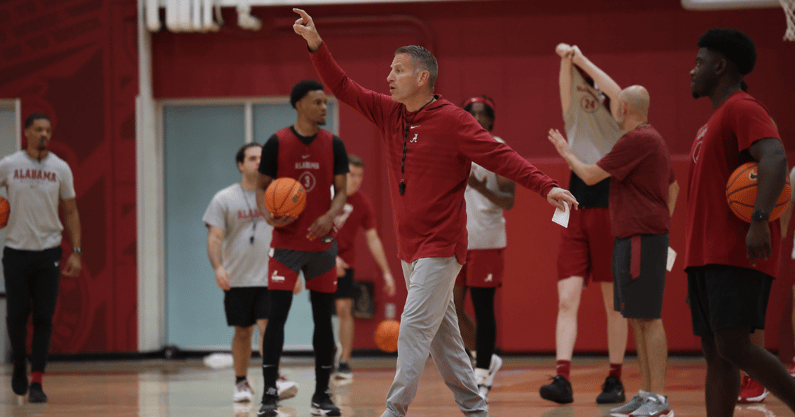On Thursday, a major update to the cost proposal for the Alabama basketball practice facility was unveiled, with adjustments expected to save millions of dollars. This new development represents not only a victory for the university’s budget but also highlights the importance of careful planning and strategic foresight in the development of high-profile sports facilities. As the University of Alabama continues to build upon its athletic reputation, particularly within basketball, the facility will play an integral role in shaping the future of the program. But the proposed cost savings and restructured plans open up opportunities for a wider range of investments, which will significantly impact the basketball team, the athletic department, and the university at large.
The Original Plan: A Vision for the Future
The initial plans for the new basketball practice facility were bold, reflecting the growing ambition of the Alabama athletics department. A modern and state-of-the-art venue was envisioned, one that would elevate the training environment for both the men’s and women’s basketball teams. The goal was to build a facility that not only provided top-tier practice courts, weight rooms, and training spaces but also featured advanced technology that would enhance player development, rehabilitation, and team strategy.
The proposed cost for this ambitious project was originally pegged at around $100 million. The plan was comprehensive, promising to rival other elite college programs’ facilities. It included amenities such as multiple full-sized courts, a strength and conditioning center, medical and recovery zones, offices for coaching staff, meeting rooms, and video analysis suites. This would create an all-encompassing space where the basketball teams could hone their skills year-round, regardless of the season.
However, such an ambitious plan required significant financial outlay, and as the project evolved, a rethinking of costs became inevitable. While the concept was sound, the realization that certain components could be modified or streamlined without sacrificing quality led to a re-evaluation of the total project cost.
The Cost Update: Key Changes and Savings
The cost update proposal, announced Thursday, reflects a recalibrated approach to the facility’s design and construction. Initially estimated to cost $100 million, the revised proposal brought the cost down by several million dollars. The savings were achieved through a combination of design changes, material adjustments, and the incorporation of more efficient construction methods. Here’s a closer look at the major changes:
- Design Adjustments: Streamlining Features
While the original design focused heavily on creating a facility that would stand out as a showpiece for the Alabama basketball program, the updated plan shifted focus toward efficiency and functionality. Some non-essential luxury features, such as extravagant lounges, high-end materials, and large-scale decorative elements, were modified or eliminated entirely. Instead, attention was concentrated on providing players with the best possible training environments, prioritizing court space, weight rooms, and recovery areas over aesthetic grandeur.For instance, the original concept included a highly detailed exterior with complex architectural elements. These were simplified in the revised design, reducing both labor and material costs while maintaining a sleek and professional look. This compromise was a strategic decision aimed at ensuring that resources were funneled into functional areas that would have the most direct impact on player development.
- Material and Construction Efficiency
Construction costs can often balloon due to high-end materials, labor shortages, or unforeseen delays. The updated proposal took into account the current economic climate and the availability of materials, opting for more cost-effective but still durable and high-quality options. For example, certain sections of the building that were originally designed with custom stone or glass were now planned with alternative materials that offered the same visual appeal but at a lower cost.Additionally, the project management team identified opportunities to streamline construction techniques, using modular systems and pre-fabricated components to reduce time and cost. These methods, while still advanced, helped lower the overall budget without compromising the structural integrity or longevity of the building.
- Optimizing Space Usage
The original design was expansive, with a broad focus on creating a large footprint for the facility. The updated proposal takes a more strategic approach to space allocation. Instead of building extra square footage, areas have been reconfigured to maximize the utility of every inch. Some spaces that were initially designed as separate rooms were merged into multi-purpose areas, ensuring that each section of the facility would be used efficiently.This approach extended to the design of administrative and coaching spaces as well. Rather than spreading out across a vast area, staff offices and meeting rooms were integrated into a more compact layout, saving both space and money. By optimizing the use of the available space, the proposal ensures that the team will have everything they need without paying for underused areas.
- Phased Construction Approach
Another major shift in the cost-saving proposal was the introduction of a phased construction approach. Originally, the plan was to complete the entire facility in one go, but now it will be built in stages. This will allow the university to begin using certain parts of the facility as soon as they are ready, such as the practice courts and training areas, while the remaining sections—like the team lounges and auxiliary spaces—are completed in later phases. This strategy helps to reduce upfront costs and allows the university to spread out expenses over several years. - Energy Efficiency and Sustainability
The revised proposal also places a strong emphasis on sustainability and energy efficiency, which not only saves money in the long term but also aligns with the university’s growing commitment to environmental responsibility. Energy-efficient lighting, HVAC systems, and insulation materials were incorporated into the design, reducing both the construction and operating costs. Additionally, the use of renewable energy sources, such as solar panels, has been factored into the updated plan, making the facility more self-sustaining and less reliant on external power sources.By focusing on energy-efficient solutions, Alabama is positioning itself as a forward-thinking institution, while also benefiting from long-term savings that can be reinvested into the athletic program.
The Bigger Picture: Implications for the Basketball Program
The cost update isn’t just about saving money; it’s about making sure that the Alabama basketball program gets the best possible facility without overextending the university’s financial resources. The savings realized through these adjustments open up new possibilities for the team, as the funds freed up can now be allocated toward other aspects of the program.
With the revised budget, the team could see enhancements in player recruitment, staff salaries, and travel accommodations. The facility itself will still be a top-tier space, but now the university has more flexibility in how it invests in the overall success of the basketball program. This also means that future upgrades can be more easily accommodated, ensuring that the facility remains state-of-the-art for years to come.
Additionally, the savings from this project might be channeled into expanding scholarships or increasing support for other athletic programs at the university. By being mindful of budgetary constraints while still committing to excellence, the Alabama athletics department is setting a strong example of how to manage large-scale projects without sacrificing quality.
Community and Campus Impact
Beyond the basketball program, the new facility is set to benefit the entire University of Alabama community. The practice facility is likely to become a focal point for student-athletes, coaches, and fans, drawing attention to the excellence of Alabama’s athletic programs. It will serve as a hub for training, development, and recruitment, enhancing the university’s overall athletic profile.
Moreover, the construction process itself is expected to bring economic benefits to the local community. With a project of this scale, local businesses and contractors will likely see an influx of work, from providing materials to offering services on site. This adds a layer of economic activity that will extend beyond the university campus and benefit Tuscaloosa and the surrounding region.
A Strategic Investment for the Future
The revised cost proposal for the Alabama basketball practice facility is an example of strategic decision-making that ensures long-term benefits for the university, its athletes, and the community. By streamlining the design, optimizing space usage, and incorporating cost-effective construction methods, the athletic department has succeeded in creating a modern, efficient, and sustainable facility without compromising its vision for success.
The savings will allow the university to reinvest in other critical aspects of the basketball program and Alabama athletics as a whole, cementing the university’s reputation as a powerhouse in both academics and athletics. Ultimately, this project is more than just a building—it’s an investment in the future of Alabama basketball, and the new proposal ensures that the program will have the resources it needs to compete at the highest levels while being financially responsible. The facility, now poised to open within the coming years, represents the future of the Alabama basketball program—and the future has never looked brighter.



